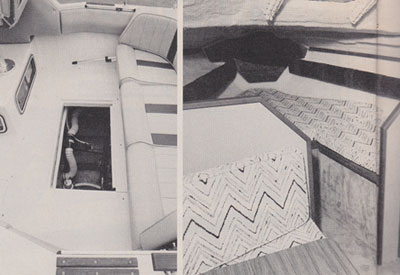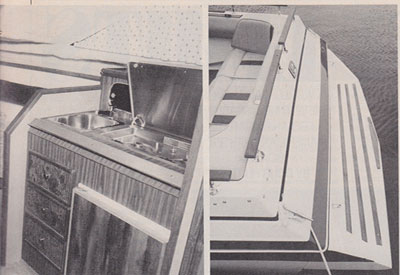Grew 239 AC
An express cruiser with hidden performance.
By Doug Dawson
The 23-foot Grew 239 AC is what could be called a small express cruiser. Its eight-foot, six-inch beam moves it out of the ranks of the eight-foot beam “mini-cruiser” into the wider “cruiser” category. Appropriate to the “cruiser” label, it features an in cabin galley, a private head, a V berth, a mid-cabin and a separate dinette. All ACF Grew boats are built in Penetanguishene, Ontario, on the site where the company has been turning out models for over 100 years as Canada’s oldest and largest manufacturer of pleasure powerboats.
The 239 AC is a new model that Grew engineered, developed and introduced in 1984. Sea trials on the 239 AC were conducted on Georgian Bay off Beausoleil Island near Penetanguishene, aboard a test boat powered by a 260 Mercruiser Stern-drive. When I first took the wheel and accelerated up to 3,000 rpm, I found the boat quite sensitive to the trim tabs. I spent a little more time acquainting myself with the boat’s reaction to tab adjustment and realized that the tabs are especially large and I had been over-compensating.
In addition, the helm seat elevates you well above the water, giving you the sensation of more movement than would a low runabout. Once the tabs were properly set, the boat continued to plane at 2,800 rpm. I repeatedly slowed the boat back to an idle, then accelerated to 3,000 rpm and, once on a plane, pulled it back to 2,800 rpm. This test and the rest of the trials were run without further trim tab adjustment.
The test boat was run with a full tank of fuel and only myself aboard. The top rpm was 4,500, which read 37 mph on the boat’s speedo. I thought it was faster because at full speed the photo boat, a 21-foot Scorpion with a 260 engine, slowly pulled away from the 239 AC. As it happens, the Mercruiser test evaluation center measures the top speed of the 239 AC at 42.9 mph at 4,775 rpm. This unexpected show of speed turns a relatively conservative looking express cruiser into a performance cruiser.
 Although most 239 AC’s have been sold with 260-hp stern-drives, this boat should perform almost as well with a lighter 230-hp engine. The smaller power option would save you money both at the time of the initial purchase and at the gas pump. In tight turns at 3,000 rpm the boat stayed on a plane and negotiated tight figure eights without dropping off. Throughout the trials and photo runs, I found the boat quiet at all speeds.
Although most 239 AC’s have been sold with 260-hp stern-drives, this boat should perform almost as well with a lighter 230-hp engine. The smaller power option would save you money both at the time of the initial purchase and at the gas pump. In tight turns at 3,000 rpm the boat stayed on a plane and negotiated tight figure eights without dropping off. Throughout the trials and photo runs, I found the boat quiet at all speeds.
This is due partially to the insulation of the solid engine compartment bulkhead and the snap-in carpet, as well as to Grew’s solid construction. There was no insulation under the decks. The forward deck is laid out like most cruisers of this size, with a teak bow pulpit and a sweeping full-length bow and side rail. The Grew 239 AC adds two teak handrails that run up the forward slope of the cabin, which make it easier and safer to move from the forward deck up to the cabin roof or to the side deck. A large, translucent hatch offers an alternative route to the forward deck.
At the corner of the cockpit is a six-inch rise in the cockpit coaming, which deflects any water running down the side deck and increases the depth of the cockpit for safety. The test boat was equipped with an optional teak swim platform, but a sculptured fiberglass platform from Grew’s Chris –Craft Scorpion line has been introduced for 1985. These molded platforms completely hides the out drive and trim tabs, and eliminates platform legs. The horizontal surface of the platform is closer to the water than the conventional teak platform.
To keep the glass platform from looking too stark, Grew has added four teak slats that also serve as a nonskid surface. It took a boat manufacturer from mosquito country to put the mooring cleats outside the cockpit cover, finally eliminating cut-outs in the canvas for dock-lines. The cleats are secured to the angle of the coaming, below the curtain snaps just above the gunwale molding.
The cockpit is wrapped with vinyl covered padded bolsters that match the helm seat and aft lounge. The wraparound aft lounge is large enough to seat three or four adults. Lifting the bottom cushions reveals a large stowage compartment. Raising the hinged backrest, you find the convertible and camper tops neatly tucked away under the back coaming.
The cockpit floor is fiberglass for easy cleaning; its carpet snaps out to dry. The forward end of the cockpit has two large raised areas. One, under the helm seat, provides height for the mid-cabin. The other, on the port side, provides deck storage for lines and fenders.
The advantage of having the cockpit floor running flat between the two separate raised areas is that you don’t have to climb over the mid-cabin compartment every time you enter and leave the cabin. The double helm seat and the single companion seat, both mounted on pedestal legs, adjust fore-and-aft and swivel. Only the helm seat has a comfortably positioned foot rest.
 The dash is neatly arranged in three tiers. The lower tier houses the switches with their fuses. When I turned on the ignition switch, all the plastic toggle switches glowed. When an individual accessory was turned on, its toggle switch lit up brightly. Molded to the forward side of the dash is a curved spot to flush-mount a compass. Around the helm, your electronics technician will find lots of spaces, vertical and horizontal, in which to mount radio stereo and other gadgets.
The dash is neatly arranged in three tiers. The lower tier houses the switches with their fuses. When I turned on the ignition switch, all the plastic toggle switches glowed. When an individual accessory was turned on, its toggle switch lit up brightly. Molded to the forward side of the dash is a curved spot to flush-mount a compass. Around the helm, your electronics technician will find lots of spaces, vertical and horizontal, in which to mount radio stereo and other gadgets.
An abundance of sea rails prevents loose items from falling off. The conventional skiff windshield is high enough to see through without ducking around the wiper motor, but not too high for me to stand and see over. The companionway is positioned slightly off-center to port, affording a little more space for areas along the cabin’s starboard side. The bi-fold cabin door is solid Burmese teak with two full-length black Plexiglas windows.
The three-piece folding teak hatch provides plenty of headroom. The interior of the cabin is decorated with light beige vinyl wall covering, light beige and brown striped upholstery and a light brown carpet. The beiges are trimmed with teak. Two full-length side windows, 10 inches high in slightly tinted glass, brighten the small cabin.
The dinette is not in the V berth, as in many boats this size. Though relatively small it is a totally separate face-to-face unit. It quickly converts to sleep one 69- inch adult with lots of elbow room, or two very small adults with no elbow room. Storage in the dinette area is offered under the two seats, in a full-length shelf outboard and also in a hanging locker, which is topped with a small storage shelf.
The V berth boasts sleeping room for two six-footers. Along both sides are shelves with padded backrests. The galley is compact, as it must be for a 23- footer, but offers all the necessities. The sink is deeper than most. The flush-mounted standard alcohol stove occupies most of the counter top. When the stove is not in use, its stainless steel lid provides a working surface for preparing cold meals. Presumably one resorts to the dinette table as a preparation surface for hot meals. A cabinet runs outboard along the length of the counter top. Below the counter is the icebox or optional fridge and three wooden drawers. The private head is a true stand-up and- move-around compartment. Grew also believes in the standard marine toilet that pumps to a separate holding tank.
A sink with fixtures is neatly installed in a small counter. A smoked mirror backsplash reflects the vanity; an ample, square mirror is on the forward bulkhead. The compartment is complete with holders for soap, paper, toothbrush and towel. On the aft bulkhead is a vanity storage area. Though windowless, the head is well lit. Light brown carpet extends in from the cabin, but under the bowl Formica is thoughtfully installed for easy cleaning. The only concession the head makes to the boat’s small size is the absence of a shower.
The mid-cabin is the roomiest I’ve seen on a 23-footer, but it can’t be compared with those offered on 25- and 26- footers. Not intended for a six-foot, three-inch person like myself, it’s a great spot for a couple of children. It is well-ventilated with two screened windows, and quite private with drapes on the windows and another across the cabin doorway. Shelves are installed in the headboard; there is also a hanging locker.
A comfortable, two-piece mattress covers the entire mid-cabin. The engine is tucked below the two center hatches of the cockpit. The forward hatch lifts out and the aft one then slides forward for access to the engine compartment and the entire top of the motor—,-you don’t have to touch or move any part of the lounge. For a major motor project, the aft lounge easily lifts off the back deck with no tools required. It is simply held in position with two one-inch-high mahogany blocks.
The engine compartment is quite deep and a full 15 inches longer than the V8 engine. A solid bulkhead is built up a foot above the bottom of the boat, with a hole positioned in the top for running wiring forward. The fuel tank lays tight to the hull under the mid-cabin. There is plenty of storage on both sides of the engine, even with factory-installed items like battery and blower, power trim and tilt, and so on.
There is no insulation on the underside of the hatches or deck, or on the hull sides. But, as I previously noted, it is still a quiet boat. In all, the Grew 239 AC is a roomy, well-considered mid-cabin express cruiser with the high speed of a performance boat.
Originally published in Canadian Yachting’s December 1984 Issue.
Doug Dawson owns Doug Dawson Yacht Sales. He is an experienced member of the marine industry and a past president of the Ontario Marina Operators Association.
Photo Captions: Right, the engine is accessible through two hatches aft of the helm station, without moving or touching any part of the lounge. The Grew 239 AC’s berth center, can sleep two six footers, and the compact galley offers all the necessities. A sculptured fiberglass swim platform from ACF Grew;s Chris-Craft Scorpion line has been introduced for 1985 on the 239 AC.
Specifications:
Center line: 23ft 5in
Beam: 8ft 6in
Cockpit length: 8ft
Height: 8ft 8in
(Keel to top of windshield )
Weight: 4,450lbs
(With 260-hp Engine)
Tankage:
Fuel: 75gal
Fresh water: 12gal
Holding: 15gal
Test boat price (1985): $42,200























